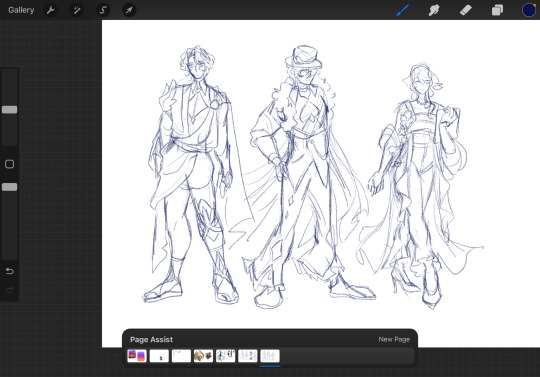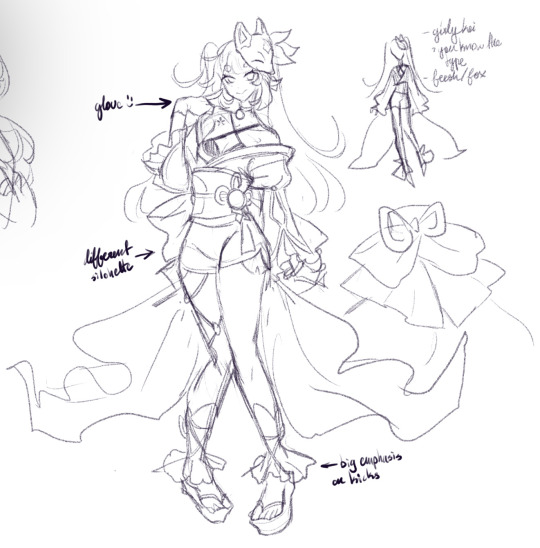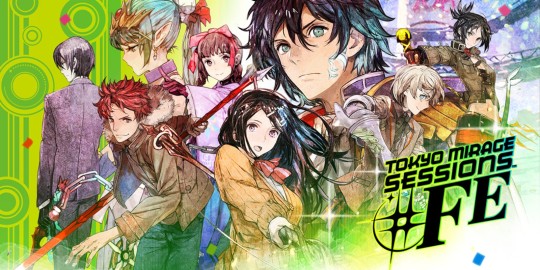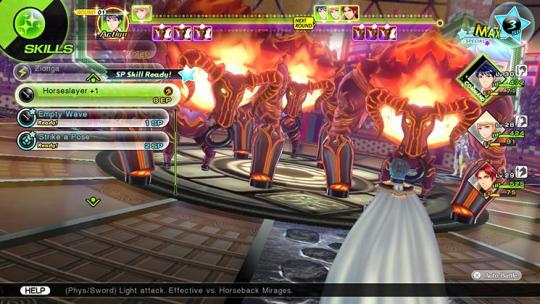#miku. i don’t like the new redesign for her. it’s not very good.
Text



i’ve been in a mood.
[image id 1: a sketch of dr. radio, aventurine, and ruan mei. the men have had slight redesigns while ruan mei has a whole new outfit.
image id 2: a sketch of sparkle from honkai star rail. she’s been slightly redesigned.
image id 2: a sketch of two redesign ideas for the vivid bad squad version of hatsune miku. one has an asymmetric button up while the other is an adjustment of the 2nd anniversary design.]
#honkai star rail#project sekai#art archive#i’m not tagging anyone specific you can ignore this#anyways. lemme talk#dr ratio’s leggings look. weird. i don’t like them#so i switched them over to shorts to emphasize the greco-roman look#i think aventurine just looks better with flared pants. i don’t like the slacks they give everyone#ruan mei is completely different#she takes Extremely vauge inspo from tang dynasty clothing#mostly i wanted her to look a bit more professional and like she Could be a biologist instead of just pretty#nothing. is wrong with hanabi she’s just using the same silhouette every other woman is so i chopped off her sleeves and gave her shorts#i think this would look better with her kicks#miku. i don’t like the new redesign for her. it’s not very good.#the cropped jacket in the front with the long coattails is just So janky#she looks super bulky too#and those fucking white thigh highs.#the brand logo look is also used. badly#so i wanted to keep that street wear look but make it less aggravating
12 notes
·
View notes
Text
Tokyo Mirage Sessions #FE: Fusion Accident?

During January of 2013, Nintendo showed off a variety of titles for the Wii U in a Direct, with a great many of them being in early development. One title raised quite a few eyebrows, collaboration between Atlus and Nintendo, a merger of the Shin Megami Tensei franchise and the Fire Emblem franchise. The game itself had just started development and it would be years before something more concrete about the game would be shown. While teased as a straightforward crossover title, upon being unveiled as Tokyo Mirage Sessions #FE, it was clear this was a game no one could have seen coming. Starring idols that fought alongside Fire Emblem characters in a battle system similar to the SMT games, Tokyo Mirage Sessions managed to alienate two fanbases at once and ultimately the game ended up bombing. But years pass and with the Nintendo Switch hitting it off well, many clamor for a Switch port of the game. With that in mind, I think it’s worth going back and looking at the game, judging it on its own merits. Are these two tastes that go good together, or is it more like toothpaste and orange juice?!
The game’s premise is incredibly, gleefully absurd: strange beings from another world, Mirages, prey on the people of Tokyo, seeking out their Performa, their creative energy and talent. People with great talent can harness their own Performa to become Mirage Masters, partnering with benevolent Mirages to keep the people of Tokyo safe while they hone their own craft. The game follows the exploits of Fortuna Entertainment as they fight off Mirages, grow as performers and try to unravel the reason behind a mass disappearance of performers five years prior to the story’s start. The game’s overall tone is…quirky, and at times the writing feels right out of a Sailor Moon knockoff from the nineties. To that end, it’s fairly harmless but not exactly engaging. The bulk of the game’s story is told at the very beginning and the very end, with a very uneventful, repetitive middle. More time is spent on the various idols, actors and models of Fortuna fending off random Mirage attacks than advancing the overall plot until about the last third of the game, and as a result I found it very hard to get invested.

Things were bad when one of the core driving forces for Tsubasa Oribe, the game’s main heroine, was solved in the first chapter. She wanted to find her sister, who was a victim of the mass disappearances five years prior to the story, and after she’s found, her whole character arc is just “to be the best idol I can be!” Speaking personally, I don’t find that engrossing enough to justify a lengthy RPG. It doesn’t help that most of the other characters are rather bland, tired archetypes that can be boiled down to two main traits. Kiria is the aloof tomboy who secretly loves cute things, Barry is an otaku who loves little girls (but not in that way we swear!), and did you know that Eleonora is biracial and loves Hollywood? Well, don’t worry, because every time she speaks one of those two subjects comes up!
To be fair, I don’t outright dislike most of the cast (except for Barry), and each main character gets a series of side stories about them that does flesh them out slightly and features a little growth, but it’s not nearly enough to make them feel like well-realized characters. Yashiro is a good example of this; one side story establishes he’s so used to having assistants do everything for him, he doesn’t know how to eat by himself. Rather than treat this like a serious issue, the side story frames it as him needing to eat so he can make his acting more believable. Entertainment work is all these characters have to define their personalities and we don’t get to see much of their personal lives at all. Itsuki and Tsubasa are noted to still be in high school, but outside of a quick shot of them in the animated opening of the game, there’s not a single scene at school. I realize I’m ragging on the story and characters a lot, but that’s a huge part of any RPG and considering the pedigree here, with the Persona and Fire Emblem franchises known for making well-loved characters…it’s hard to not feel disappointed.
You might be wondering where the whole Fire Emblem influence fits into all this. Mirages are sometimes monsters…and sometimes they’re characters from the Fire Emblem series, with serious redesigns that make them virtually unrecognizable. Overall, it’s a plot point that feels pretty half-baked and tacked on, though there are plenty of nods to the series in the game. To be fair, the gameplay side of the equation features a lot more influence from both series, resulting in a better fusion of ideas.

At its core, Tokyo Mirage Sessions is like any other Atlus RPG. You travel around small hub areas, then enter rather plain dungeons and fight monsters in turn-based battles, trying to find their weaknesses and exploiting them as often as possible. Things change with the introduction of Session Skills though. In the normal SMT games, hitting an enemy’s weakness grants you an extra turn, while in Persona this sets up you for an All Out Attack. In TMS, however, hitting a weakness can trigger a Session Skill, where your other party members jump into the fight and strike a blow of their own. So if Itsuki uses a lightning spell on a monster weak to it, Tsubasa jumps in with a lance attack, as an example. The Session chains start out fairly small, but as you progress through the game, sessions grow longer and more damaging, to the point where one character’s turn can lead to attacks in the double digits. If there’s one thing this game does right, it’s a constant sense of progression; you’re always learning new skills, creating new Session chains and gaining new party members. There are a number of moves characters can learn that tie into their side stories and character growth too, like Ad-lib Performances (randomly turning a normal attack into a powerful cinematic attack that always triggers Sessions) and Duo Arts (two characters team up for a super move that resets the Session chain).
The Fire Emblem attack triangle and various other unit weaknesses seamlessly integrate into the SMT battle system. Fighting a flying enemy? Nail it with arrows or wind magic. An enemy has an axe? Use a sword move on them. And so on. Knowledge of Fire Emblem really helps out here, as otherwise this game has the same “challenge” of having to guess to see what element or attack type a given enemy is weak to during their first encounter. It can feel pretty satisfying to get off long chains on enemies, whittling them down to nothing, and you’re given plenty of tools to work with, but that does lead into another problem…
Rather than fuse demons or Personas together to get new skills (or party members), in TMS, you gain drops from enemies that can be turned into weapons that the party members and their Mirages wield. The weapons have a separate level up from the party, and impart new skills until they reach their cap, whereupon you’re encouraged to form a new weapon as soon as possible. Players interact with the Fire Emblem character Tiki, reimagined in this game as a virtual idol comparable to the likes of Hatsune Miku, to forge new weapons, or unlock new passive skills. This is a fine system and all, if a little lengthy with elaborate animations each time you do it (which can be skipped), but the problem is that it’s too frequent. You level weapons up ridiculously fast, and gain new drops to make new weapons just as fast. This doesn’t seem like a problem except that it requires you to repeatedly leave any given dungeon to go talk to Tiki. You can take all of ten steps into a dungeon, get in a few fights and suddenly the game wants you to leave to get new weapons and skills. And it’s certainly possible to just hold off on it, but you’re missing out on worthwhile new skills and attack boots; it’s just more efficient to constantly return to your headquarters. The dungeons, to be fair, are designed with this in mind, with warp panels you can unlock that cut down on backtracking a lot, but that doesn’t change the fact that you’re constantly starting and stopping, slowing progression down to a crawl.
This really is a result of this game being quite padded. Overly elaborate animations for everything, dungeons that throw enemy encounters at you nonstop, time-consuming hazards and gimmicks in each dungeon…and the constant backtracking to Tiki. A good chunk of my time with the game was really spent just combing through menus for weapons and skills, as well as lots of loading screens, or just watching the same animations again and again. While it’s nice to see a 14 hit Session chain, when you KEEP seeing those same moves again and again and again, it gets old. I feel like some streamlining could have gone a long way towards fixing these complaints, like an option to warp directly to the Bloom Palace where Tiki resides, rather than to Fortuna’s offices, followed by a loading screen to see Tiki. Or better yet, make more use out of the Game Pad by letting us manage new weapons and skills while on the go in dungeons. As it stands, the Game Pad is used to display a rather basic map of any given area, and showcase posts made in Topic, an in-game social media app every main character uses. Considering Tiki’s a virtual idol and she even made an app that lets you know when new weapons and skills are ready, it doesn’t seem like much a stretch to me that at some point in the game, you could have gotten an app that let you make new weapons on the spot…but alas, that’s not how the game works.
In the end, really, Tokyo Mirage Sessions is a game that has a fair bit of charm, but a number of odd design decisions that kept me from getting as engaged as I would have hoped. I actually dropped the game multiple times over the course of about two years before I finally beat it, because of how bored I got. The characters are dull, the story doesn’t really exist until the last ten hours or so, and the combat takes a while to really open up, and even then, it can be kind of repetitive. But having said that, there’s still a lot to like here. The music is pretty on-point, considering idols are a big component of the game. There are at times animated music videos for various characters that clearly had a lot of work put into them. The game’s overall aesthetic is colorful, filled with bright neon greens and pinks, with nice touches here and there on the UI and in-battle animations. Like how Mamori is so small, she needs to use herself as a counterweight to swing her huge axe, or how characters sign their names when doing spells, like doing an autograph. The overall premise, that performers can harness their creative energy and bring to life manifestations of their craft, is cool too. That really comes out when you see some of the Duo Arts or Ad-libs. Tsubasa summons a massive tidal wave to reenact a soda commercial she did, or Touma becomes the tokusatsu super hero he plays on TV for real, complete with theme song blaring in the background! It’s cool stuff, but it only goes so far.
Tokyo Mirage Sessions #FE isn’t really a bad game, though it does have a fair number of issues. The game really had to fight an uphill battle after its official unveiling, as years had passed with people speculating how a crossover of two very different franchises would work. I think it’s safe to say that idols using the power of music to beat back monstrous versions of Fire Emblem bosses weren’t what anyone was thinking. Combine that with some drama during the game’s localization, and you had a game that ended up being dead on arrival. Had the game been announced differently, maybe it would have been better received. There’d still be some issues with the game on the whole, though, and when I see people calling this one of the best games on the Wii U I have to raise an eyebrow a bit. It’s not without its charms, to be sure, but TMS to me was a lot of flash, with too little substance to justify a lot of the busywork found within. It’s still a solid premise I’d love to see Atlus or Nintendo try again someday though.
Until next time,
-B
#xb-squaredx#blog#review#tokyo mirage session#shin megami tensei#fire emblem#nintendo#atlus#intelligent systems#JRPG#Wii U
0 notes